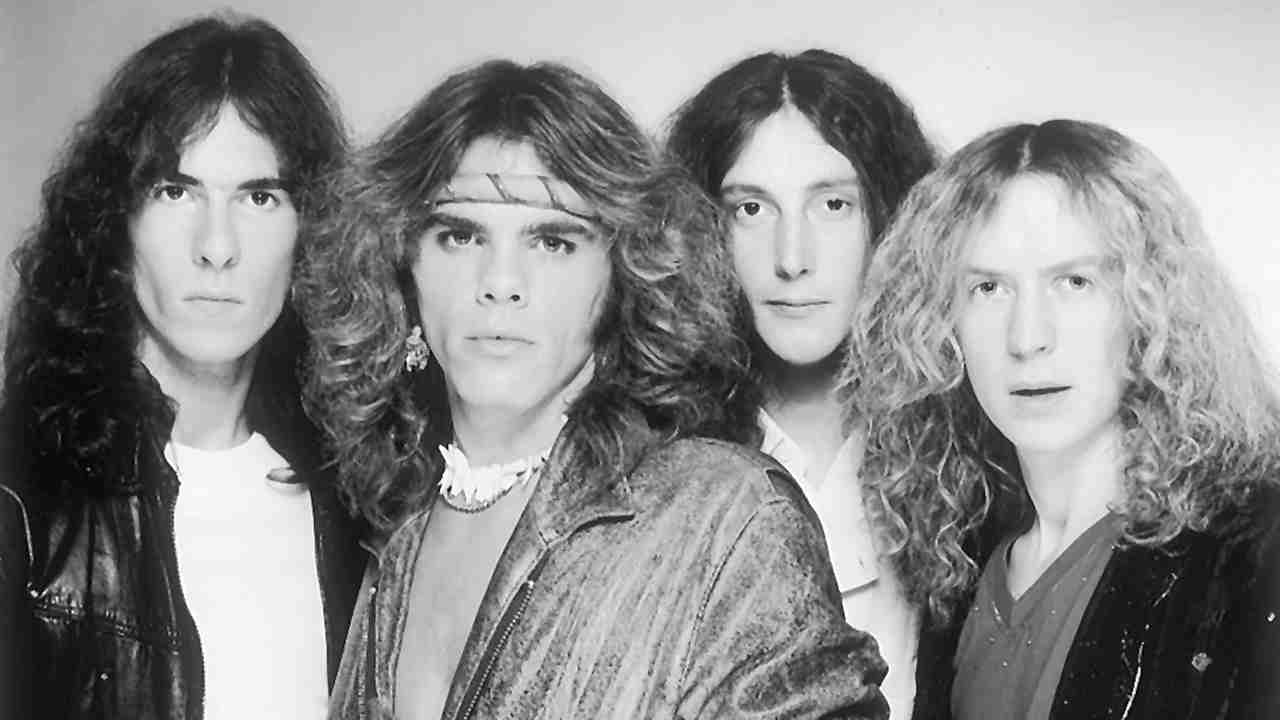Krautrock, communism and chaos: the anarchic story of Can
Avant-garde Germans Can influenced everyone from Bowie to Mark E. Smith and beyond. Geoff Barton looks at their cult appeal and legacy

The undisputed kings of krautrock, Can formed in Cologne in 1968. They were avant-garde – and then some – and their influences came from an immense variety of sources: from The Velvet Underground to Karlheinz Stockhausen; from The Beatles to Frank Zappa’s Mothers Of Invention; from free jazz to contemporary classical music; from Jimi Hendrix to The Goombay Dance Band. Only kidding about that last one. But in truth, nothing should surprise us about these übercool German improvisationalists.
From the outset it was plain that Can were no ordinary band. It’s significant that the man widely regarded as the genius behind Can, co-founder Holger Czukay, had a far from conventional musical upbringing. Czukay didn’t start off singing in the school choir or badgering his parents to buy him a Chad Valley acoustic guitar for Christmas. Alright, so he had a dream about becoming a conductor – but that had less to do with baton-twirling in front of an orchestra, and more to do with electricity. Conducting – geddit?
Czukay might have studied under the aforementioned Stockhausen but, in common with many of the leading lights of krautrock, he was more interested in the devious mechanical innards of music rather than in straightforward rock or pop. As Czukay said in an interview with writer Phil England: “I didn’t know if I wanted to become a technician or a musician. But I know for sure that I never intended to become a rock musician.”
It’s significant, too, that apart from Jaki Liebezeit, a jazz drummer who had played with Chet Baker, the other members of Can also came from eclectic backgrounds. (“He [Jaki] was a very good teacher for us,” commented Czukay to writer Jason Gross, “Can was concentrated on getting along with genuine rhythms because of Jaki.”)
The original line-up of Can was completed by keyboard player Irmin Schmidt, who, like Czukay, had studied under Stockhausen), guitarist Michael Karoli and American composer David Johnson, who played the flute but preferred the grandiose title of ‘electronic musician’. Cukay himself played bass. “I could hide myself quite good because I was afraid I was not good enough,” he laughed.
If you’re a non-Can-ophile, you might assume that the band’s name has something to do with Andy Warhol: multiple tins of Campbell’s Soup in day-glo colours and all that. Certainly some of Can’s music could be seen as a soundtrack to Warhol’s more garish nightmare visions, but the only E-numbers associated with Can are of the electronic kind.
The band had had a couple of previous names – Inner Space and The Can – before settling on plain ol’ Can. Or perhaps, strictly speaking, it should be C.A.N. – standing for Communism, Anarchism, Nihilism (an acronym coined by drummer Liebezeit). Keyboardist Schmidt, meanwhile, described Can best, calling the band an “anarchistic community”. However, the rest of the world just raised its eyebrows, cupped its ears and summed Can up in one word: difficult.
Sign up below to get the latest from Classic Rock, plus exclusive special offers, direct to your inbox!
“We were studied dilettantes,” Czukay explained to writer Mick Sinclair. “Experts on music, but when it came to playing rock music, we played like pigs! We didn’t know what rock music was.” In the autumn of 1968, Can brought in the crazed-but-creative American singer, Malcolm Mooney, to bolster their line-up. In truth, Mooney didn’t so much sing as rant in an off-key, demented fashion.
The following year David Johnson left, displeased that Can music’s was taking, as he saw it, a more rock-oriented direction. To everyone else it still sounded as wild and experimental as hell. After a series of sporadic recordings – one of which, an album called Prepared To Meet Thy Pnoom, was rejected by record companies for being unlistenable; “No label wanted to get hold of that kind of music,” said Czukay.
Can’s first album proper emerged in 1969: Monster Movie. During the recording of Monster Movie, Czukay said, “we thought more of a collapsing building in a slow-motion picture than becoming heroes on our instruments”. It was a comment that German industrial band Einstürzende Neubauten later latched on to when they began creating ‘music’ by bashing pieces of scrap metal together in Berlin in 1980: Einsturzende Neubaten’s name, translated into English, means ‘collapsing new buildings’. The band themselves will tell you it’s a reference to the cheap houses that were built after 1945, as Germany scurried to recover from the war.
We digress. Monster Movie was, and remains, a psychotic, jarring, gripping, hypnotic, minimalist, inscrutable, psychedelic – you name it – piece of music. Key to Can’s appeal – or lack of it, at the time – was the repetitive use of bass and drums, most notably of Yoo Doo Right – a song that had begun life as a sprawling six-hour jam.
Without a single break for tea and biscuits. Can’s music was ill-formed and chaotic, all right – and it was already having an adverse effect on singer Mooney. He suffered a mental breakdown on stage and a doctor advised him to leave the band for psychological reasons. For the sake of his sanity he caught the next flight home back to the States.
“With Malcolm Mooney, we were very fresh,” Czukay told writer Richie Unterberger. “He was a great rhythm talent. He was a locomotive. He pushed us into the rhythm, and gave us the feel that this was the right thing to do.”
At one performance, Mooney had sung the phrase ‘upstairs, downstairs’ for three hours – continuing the mantra even when Can had stopped playing. Again, without a single break for…
Can brought in the less volatile vocalist Kenji ‘Damo’ Suzuki, a Japanese hippy who they had come across busking outside a café. “Damo was a different kind of singer,” said Czukay, “and so the group achieved some much-needed stability.”
Suzuki had a baptism of fire with Can: he played his first gig with them on the day he was discovered! “I went up to Damo outside the café and asked him if he was free for the evening,” Czukay wrote in his Short History Of Can. “I said: ‘We are an experimental rock group and we have a concert tonight – it’s sold out.’ Damo said he had nothing special to do, so why shouldn’t he sing? The venue was packed and Damo started murmuring like a meditating monk. Then all of a sudden he turned into a fighting samurai. The audience was shocked and almost everybody left the hall.”
Can released a stopgap album, Soundtracks, in 1970, which featured both Mooney and Suzuki on vocals. They then went on to create their two most critically acclaimed works: Tago Mago (1971, their second ‘official’ album, accurately described by one critic as being based on ‘long improvisations built around hypnotic patterns’) and Ege Bamyasi (1972). The latter even generated an unlikely hit single, Spoon, which reached the top of the German charts.
In late 1971 Can – who had always created music in their very own studio – moved to a new place in an old cinema just outside of Cologne. The band had “originally been sponsored by this man, an art collector, who rented a castle [Schloss Norvenich],” said Czukay. “We didn’t have any money at the time so he gave us a room where we established a studio, with the most simple equipment you can imagine.”
When they moved to the cinema, guitarist Michael Karoli told writer Andy Gill, Can nailed 1,500 ex-army mattresses to the walls as soundproofing. “They must have been an inspiration,” Karoli said. “We were surrounded by millions of erotic dreams, and probably sperm!”
Soon enough, over in Britain, someone called Can’s deeply unconventional music ‘krautrock’ – and the term stuck. “What happened was,” Czukay explained to writer Jason Gross, “we made many tours through England and suddenly it came up that the British press was aware of several of the other German bands and called us ‘krautrock’. I asked an Englishman: ‘How can I understand this? What does ‘kraut’ mean? Is it something positive or negative?’ Maybe ‘krauts’ come from the Second World War.”
However, Czukay soon latched on to the English sense of humour and decided ‘krautrock’ was a term of affection, not ridicule or indeed xenophobia. “We were more or less naturalised into England,” Czukay said. “How this happened was a miracle. We were Germans… but the English audience felt that this was something new.”
Can continued on their wildly individualistic path. Incessant touring helped open people’s ears to the idiosyncratic appeal of their music. In the band’s heyday, a Can album would sell in the region of 20,000 to 30,000 copies in Britain – remarkably healthy for a so-called ‘cult’ German band.
The weirdness kept on coming: the albums Future Days (1973) and Soon Over Babaluma (1974) might have lacked the disconcerting edge of their predecessors but they were no less ambitious. Indeed Future Days is today regarded as one of the earliest examples of ambient music. In between the release on these two records, ‘Damo’ Suzuki left Can to marry his German wife – and become a Jehovah’s Witness.
Czukay compared Suzuki’s departure to “the feeling of a powerful fist striking into one’s stomach. We tried out many other singers, but nobody suited us any more. An era came to an end.” Karoli and Schmidt shared vocal duties for a couple of albums and singer-songwriter Tim Hardin even sang with the band for a very brief time.
Can signed a prestigious record deal with Virgin and scored their only British hit single with I Want More – but the crazed freneticism of their music was receding slowly into the past. After the albums Landed (1975) and Flow Motion (1976) Can were joined by ex-Traffic bassist Roscoe Gee and percussionist Rebop Kwaku Baah.
More releases followed in quick succession: Saw Delight (1977), Out Of Reach (1978) and Can (1979). Sadly, as the 1970s wound down, Czukay’s influence on the band began to wane. “In the beginning we were a real group, and entire group,” Czukay told writer Richie Unterberger. “That means we were recording on two tracks. Then when we became successful we were able to afford a multi-track machine. From this moment on, you could say it was the beginning of the end for Can. It was: ‘I want to hear guitar’, or ‘I want to hear the bass’. Everyone was criticising each other about what he’s doing wrong and so on.”
With the arrival of Roscoe Gee on bass, Czukay found himself marginalised. He began to explore alternative means of making music through shortwave radios, morse code, tape recorders and suchlike. It was as if Czukay had gone full circle, as he was interested in repairing broken radios and televisions when he was still at school. Czukay left Can at the tail-end of 1977. He didn’t appear on Out Of Reach but helped out on the production to Can, his final contribution to the classic era of the band.
After the break up, the various members of Can have reunited sporadically, although sadly guitarist Michael Karoli died of cancer in 2001. Czukay continued to work on movie soundtracks and blaze a trail in ambient music, collaborating with numerous contemporary musicians including Jah Wobble and David Sylvian, until his own death in 2017.
Numerous artists have claimed to have been influenced by Can: David Bowie, Talking Heads, Joy Division and The Fall, to name but four. Indeed the latter band had a song – I Am Damo Suzuki, paying tribute to Can’s Japanese singer – on their 1985 album This Nation’s Saving Grace. (Fall frontman Mark E. Smith was a renowned Can follower: Von Südenfed – his techno project with Mouse On Mars – was heavily Can and krautrock influenced.)
When he left The Sex Pistols, John Lydon claimed he modelled PiL directly after Can’s, er, image… However, with typical modesty, Czukay reckons fellow krautrockers Kraftwerk are more of an influence on today’s music scene than Can.
“In German the DJs and the young people, their father wasn’t Can, it was Kraftwerk,” Czukay told writer Richie Unterberger. “That has something to do with the fact that Can was a real band, but a lot of today’s new music is not based on the idea of forming a band.”
According to Czukay it was on stage, not on record, where Can really excelled: “When it comes to making a big performance out of nothing, Can can become very important. We went out here with empty heads. We just went on stage, and whoever threw the first stone, we caught it and threw it straight back. And that was the beginning of the concert.”
Geoff Barton is a British journalist who founded the heavy metal magazine Kerrang! and was an editor of Sounds music magazine. He specialised in covering rock music and helped popularise the new wave of British heavy metal (NWOBHM) after using the term for the first time (after editor Alan Lewis coined it) in the May 1979 issue of Sounds.

